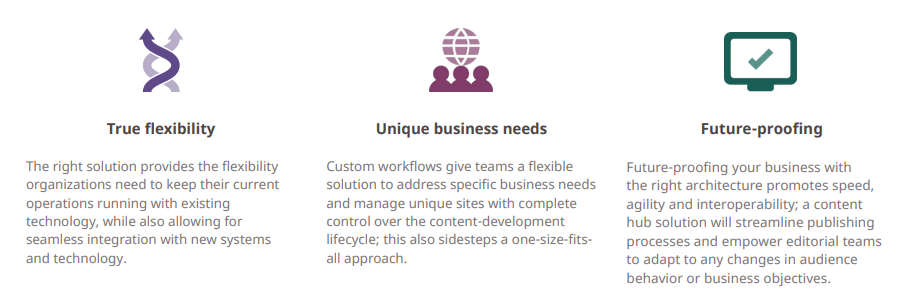Understanding the differences between a content hub and traditional CMS | Brightspot
Warning: Undefined array key 0 in /home/dmc/public_html/wp-content/themes/DMC/functions/helpers.php on line 752
Uncategorized
Digital transformation is no longer optional—it’s essential and urgent. The pandemic accelerated this need, prompting organizations to rapidly adapt to shifting consumer demands. 97% of executives report that the pandemic hastened their digital transformation efforts, and 79% have increased budgets for this purpose. Despite this awareness, many organizations struggle to take even small steps forward in their digital journey to achieve significant results.
Fortunately, there are solutions and technologies designed to facilitate smooth and successful transitions, ensuring consistent progress. At Brightspot, our guiding principle is to regain control. We integrate legacy and new systems into a unified, modern hub for seamless management and advancement. Here’s how:
Benefits of a Modern CMS
A decade ago, businesses rushed to adopt cutting-edge technologies to gain a competitive edge and streamline operations in an increasingly digital world. This often led to multiple disparate systems, significant technology investments, and inefficient processes across siloed teams. For publishers, this resulted in slow, chaotic content strategies and workflows.
Today, organizations and publishers are shifting to powerful content hubs at the center of their digital strategy. This is a significant change from previous approaches. The need for content to be at the heart of digital strategy is driven by more channels and greater opportunities to connect with customers. Modern, scalable solutions are necessary to transform content businesses for the future.
Modern CMS technologies offer flexible, scalable content management capabilities, all centered in a content hub. These systems provide the experience that organizations and their teams want and that their customers expect. When teams embrace the right-sized technology centered in one hub, they experience:

Evolving business challenges, impact on content management
Organizations are at various stages in their digital transformation journeys and have different needs for success in their unique environments. Adding to the complexity, businesses are continuously facing new and evolving challenges.
Disaster and Crisis Preparedness
The COVID-19 pandemic has highlighted the importance of disaster and crisis preparedness. The term “pivot” was prominent in 2020, and the ability to adapt quickly remains crucial. How does this relate to content? Centralizing content operations in a single hub enables swift adjustments to business and content strategies. With operations consolidated and adaptable technology, organizations can pivot more efficiently, set up new workflows, and launch new channels without being bogged down by slow processes.
At-Home Everything
With consumers spending more time at home, how does this affect content creation and management? A centralized content hub fosters creativity and easier collaboration. Intuitive technology lets you focus more on crafting engaging content rather than managing its delivery, which is already streamlined.
Data Overload
As companies collect more data through advanced technologies, understanding and accessing this information can be overwhelming. However, from a content management perspective, knowing how your content performs is crucial for deciding what to keep or discard. Centralizing performance data simplifies the management of the entire content process.
Given these challenges, a modern content hub offers more than just traditional CMS functionality. It unlocks your digital potential by addressing these issues efficiently.

Brightspot CMS: A content, data, and integrations hub
- Benefits of a modern CMS
- Evolving business challenges, impact on content management
- Brightspot CMS: A content, data, and integrations hub
Number of Pages:
- 8 pages
Pricing:
- Free
Warning: Undefined array key "sidebar_ads" in /home/dmc/public_html/wp-content/themes/DMC/functions/helpers.php on line 824





